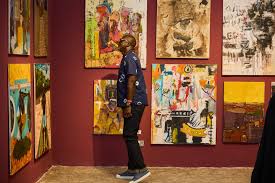The first thing that catches the eye as one enters the +234 Art Fair is the enormity of a space dedicated primarily to emerging Nigerian art. Paintings, sculptures, digital art, and installations stretch for miles, inciting a slight dizziness.
For the five days that the fair will be open this year, people will mill about the white-washed walls where over 300 artworks are on display. They will visit the children's gallery and observe the inventive works in the digital art section. More than anything, the fair will brim with art savants and people who have come to regard +234 as an avenue to discover fresh talent. An urgent necessity at a time like this.
As global art institutions report financial difficulties and inflation triggers a decline in art sales and dwindling opportunities for emerging artists, art fairs like +234 make it especially important for emerging and even mid-tier artists in the country to find buyers or even a platform to show their work.
While art spaces can sometimes be exclusionary, designing their programming to appeal to specific, often monied demographics, +234 seeks to change the culture around art patronage, especially with its second edition. The idea is to dismantle preconceived ideas of who should buy art. Instead, it introduces a culture where everyone sees themselves as patrons with a sense of duty to protect and support the arts.
"The quality of art here [in Nigeria] is unbelievable. We don't know what we have, and we need people to understand that artists need support. You could support them by buying their first piece or just mentoring them, or if you're a financial person, giving them financial advice when they make money, or you could give someone a space in your house (for residency) or just be an encourager." At the core of the fair's message is this: one doesn't need to be a collector to be a patron.
First, Asinugo curated a booth at the fair, comprising solely of artworks owned by everyday people. Bankers, workers, and people without immense entrenchment in art have come to understand the importance and thrill of appreciating art even without expert knowledge.
"If you don't have a story structure before you begin an exhibition, what you could have is a disjointed experience, especially when it's a big fair," Asinugo explains. The big challenge was figuring out how to relate this idea of collective patronage to people of all ages and social brackets.

"How do you extrapolate the meaning of championing patronage of Nigerian art in a very digestible way?" Asinugo says building this narrative required guiding attendees and showing them the varied ways patronage can exist.
As art fairs like +234 continue to build infrastructures for Nigerian artists on the ground, a renewed sense of responsibility and protection for our art ecosystem is likely to develop even further.
As Asinugo puts it, "We're all patrons of the art. If you embrace this identity as a patron, perhaps you will see it as more than just art. We have a duty to preserve this ecosystem."
Kindly,Subscribe with your Valid Email Address and receive Relevant Notifications to your active Device with Professionalism.
Thankyou for the Scheduled Quality Ample Time.
